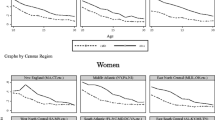Abstract
Recent changes in US immigration policy anddomestic welfare policies affecting immigrants haveled to concerns that families will face greaterpressure to provide for extended family members.Extended family households are important resources fornew immigrants to the USA and an integral part of theadaptive strategy of immigrants. This paper examinesthe competing roles of duration of residence in theUSA, aging and changes over time in explainingincreases in extended family living between 1980 and1990. The results from a pooled sample of 1980 and1990 Census data indicate that recent arrivals aremore likely to share households with extended kin butit is older immigrants who face an increasedlikelihood of such coresidence over time. Multinomiallogistic regression analysis demonstrates that thelife course pattern of coresidence remains whenchanges in socioeconomic status are controlled. Theresults suggest that policy changes limiting publicfunds available to new arrivals will have a largerimpact on families sponsoring older family members.
Similar content being viewed by others
References
Angel, R. & Tienda, M. (1982). Determinants of extended household structure: cultural pattern or economic need?, American Journal of Sociology 87: 1360–1383.
Biddlecom, A. E. (1994). Immigration and coresidence in the United States since 1960. Paper presented at the annual meetings of the Population Association of America, Miami, Florida.
Blank, S. & Torrecilha, R. S. (1998). Understanding the living arrangements of Latino immigrants: a life course approach, International Migration Review 32(1): 3–19.
Borjas, G. J. (1994). The economics of immigration, Journal of Economic Literature 32(4): 1667–1717.
Boyd, M. (1991). Immigration and living arrangements: elderly women in Canada, International Migration Review 25(1): 4–27.
Burr, J. & Mutchler. J. E. (1993). Ethnic living arrangements: cultural convergence or cultural manifestation, Social Forces 72(1): 169–179.
Chavez, L. R. (1990). Coresidence and resistance: strategies for survival among undocumented Mexicans and Central Americans in the United States, Urban Anthropology 19(1-2): 31–61.
Census of Population and Housing (1990). Public Use Microdata Samples U.S. [machine readable data files]. Prepared by the Bureau of the Census, Washington, DC: The Bureau [producer and distributor], 1992.
Cooney, T. M. & Uhlenberg, P. (1992). Support from parents over the life course: the adult child's perspective, Social Forces 71(1): 63–84.
Ermisch, J. F. & Overton, E. (1985). Minimal household units: a new approach to the analysis of household formation, Population Studies 39: 33–54.
Espenshade, Th. J., Baraka, J. L. & Huber, G. A. (1998). Implications of the 1996 welfare and immigration reform acts for US immigration, Population and Development Review 23(4): 769–801.
Glenn, N. D. (1977) Cohort analysis. Beverly Hills, CA: Sage Publications.
Glick, J. E., Bean, F. D. & Van Hook, J. V. W. (1997). Diverging trends in family/household structure among US immigrants and natives: comparisons over two decades, Journal of Marriage and the Family 59(1): 177–191.
Glick, J. E. & Van Hook, J. V. W. (1998). Race and ethnic differences in the transition to extended family living among older adults in the United States. Paper presented at the 1998 annual meeting of the Population Association of America, Chicago, Illinois.
Goldscheider, F. K. & Goldscheider, C. (1991). The intergenerational flow of income: family structure and the status of black Americans, Journal of Marriage and the Family 53: 499–508.
Goldscheider, F. K. & Waite, L. J. (1991) New families, no families: the transformation of the American home. Berkeley, CA: University of California Press.
Gordon, M. M. (1964). Assimilation in American life: the role of race, religion and national origins. New York: Oxford University Press.
Jensen, L. (1991). Secondary earner strategies and family poverty: immigrant-native differentials, 1960-1980, International Migration Review 25(1): 113–137.
Kramarow, E. A. (1995). The elderly who live alone in the United States: historical perspectives on household change, Demography 32(3): 335–352.
Landale, N. S. (1997). Immigration and the family: an overview, in: A. Booth, A. C. Crouter & N. Landale (eds.), Immigration and the family: research and policy on US immigrants. Hillsdale, NJ: Erlbaum.
Massey, D. S. (1990). Social structure, household strategies, and the cumulative causation of migration, Population Index 56(1): 3–26.
Michalowski, M. (1987). Adjustment of immigrants in Canada: methodological possibilities and its implications, International Migration 25(1): 21–39.
Moen, P. & Wethington, E. (1992). The concept of family adaptive strategies, Annual Review of Sociology 18: 233–51.
Myers, D. & Lee, S.W. (1996). Immigration cohorts and residential overcrowding in southern California, Demography 33: 51–65.
National Governors' Association, National Conference of State Legislatures, and American Public Welfare Association (1996). Analysis of the Personal Responsibility and Work Opportunity Reconciliation Act of 1996.
Ram, M. & Wong, R. (1994). Covariates of household extension in rural India and change over time, Journal of Marriage and the Family 56: 853–864.
Ruggles, S. (1987). Prolonged connections: the rise of the extended family in nineteenthcentury England and America. Madison, WI: University of Wisconsin Press.
Rumbaut, R. G. (1997). Ties that bind: immigration and immigrant families in the United States, in: A. Booth, A. C. Crouter & N. Landale (eds.), Immigration and the family: research and policy on US Immigrants. Hillsdale, NJ: Erlbaum.
Van Hook, J. (1998). Pre-reform assessments of SSI eligibility and participation among elderly non-citizens. Paper presented at ‘Future Demographic Trends and their Potential Effects on Supplemental Security Income’, Academic Symposium sponsored by Howard University School of Social Work and Social Security Administration Office of Policy, Washington, DC.
Wilmoth, J. M., DeJong, G. F. & Himes, C. L. (1994). Living arrangements among elderly immigrants in the United States. University Park, PA: The Pennsylvania State University, Populationn Research Institute, Working paper Series, No. 94-26.
Wolf, D. A. (1984). Kin availability and the living arrangements of older women, Social Science Research 13: 72–89.
Author information
Authors and Affiliations
Rights and permissions
About this article
Cite this article
Glick, J.E. Nativity, duration of residence and the life course pattern of extended family living in the USA. Population Research and Policy Review 19, 179–198 (2000). https://doi.org/10.1023/A:1006305620222
Issue Date:
DOI: https://doi.org/10.1023/A:1006305620222




